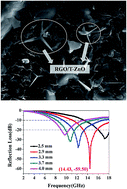Investigation on the optimization, design and microwave absorption properties of reduced graphene oxide/tetrapod-like ZnO composites
Abstract
A novel microwave absorption composite was fabricated by mixing reduced graphene oxide (RGO) and tetrapod-like ZnO (T-ZnO). The microwave absorption properties of the fabricated composites with different components were investigated. The effects of RGO mass fractions and thickness of composites on microwave absorption properties were studied in the range from 2 to 18 GHz. The electromagnetic parameters showed that the RGO/T-ZnO composites were mainly dependent on dielectric loss. The composites with 5 wt% RGO and 10 wt% T-ZnO had the optimum microwave absorption properties at the thickness of 2.9 mm, and the corresponding minimum reflection loss was −59.50 dB at 14.43 GHz. The bandwidth corresponding to the reflection loss below −20 dB was 8.9 GHz (from 9.1 GHz to 18.0 GHz) when the thickness was in the range of 2.5–4.0 mm. Thus, the composite has a low reflection loss value and wide effective absorption bandwidth in X-band (8–12 GHz) and Ku-band (12–18 GHz), which has great potential for military stealth. The excellent microwave absorption properties were mainly attributed to dielectric relaxation and polarization of RGO, electronic polarization from the needle-like tips of T-ZnO, electrical conduction loss and multiple scattering.


 Please wait while we load your content...
Please wait while we load your content...